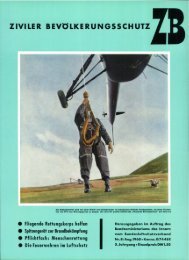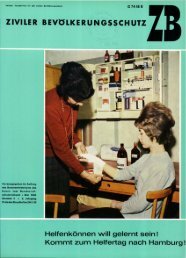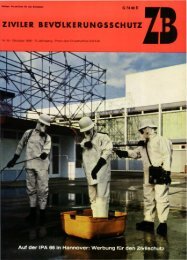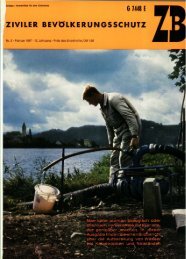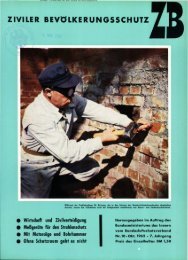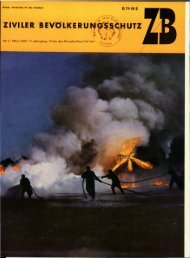Zivilschutz- Forschung - Bundesverwaltungsamt
Zivilschutz- Forschung - Bundesverwaltungsamt
Zivilschutz- Forschung - Bundesverwaltungsamt
Sie wollen auch ein ePaper? Erhöhen Sie die Reichweite Ihrer Titel.
YUMPU macht aus Druck-PDFs automatisch weboptimierte ePaper, die Google liebt.
37. Castro Delgado, R. and P. Arcos Gonzalez (1998). „[Risk of chemical disaster<br />
as a public health problem].“ Rev Esp Salud Publica 72(6): 481-500.<br />
38. Chander, J. (2001). „Water contamination: a legacy of the union carbide<br />
disaster in Bhopal, India.“ Int J Occup Environ Health 7(1): 72-3.<br />
39. Chen, H. L. (1987). „Emergencies from hazardous materials. An overview.“<br />
Postgrad Med 81(3): 127-9, 132-6.<br />
40. Cieslak, T. J. and E. M. Eitzen, Jr. (2000). „Bioterrorism: agents of concern.“<br />
J Public Health Manag Pract 6(4): 19-29.<br />
41. Clark, C. A. (2000). „The threat is real.“ Tex Med 96(6): 9.<br />
42. Cohen, M. A. and L. J. Guzzardi (1983). „Inhalation of products of combustion.“<br />
Ann Emerg Med 12(10): 628-32.<br />
43. Cozzani, V. and S. Zanelli (1999). „Precursors of dangerous substances formed<br />
in the loss of control of chemical systems.“ J Hazard Mater 65(1-2):<br />
93-108.<br />
44. Craig, D. K., R. L. Baskett, et al. (1999). „Recommended default methodology<br />
for analysis of airborne exposures to mixtures of chemicals in emergencies.“<br />
Appl Occup Environ Hyg 14(9): 609-17.<br />
45. Craig, D. K., J. S. Davis, et al. (2000). „Derivation of temporary emergency<br />
exposure limits (TEELs).“ J Appl Toxicol 20(1): 11-20.<br />
46. Cullinan, P., S. Acquilla, et al. (1997). „Respiratory morbidity 10 years after<br />
the Union Carbide gas leak at Bhopal: a cross sectional survey. The International<br />
Medical Commission on Bhopal.“ Bmj 314(7077): 338-42.<br />
47. Daniels, W. J. and A. Miller (2001). „Computer resources for planning and<br />
responding to chemical emergencies.“ Appl Occup Environ Hyg 16(6):<br />
645-8.<br />
48. Davis, J. A. (1996). „Sadness, tragedy and mass disaster in Oklahoma City:<br />
providing critical incident stress debriefings to a community in crisis.“ Accid<br />
Emerg Nurs 4(2): 59-64.<br />
49. Dayal, H. H., T. Baranowski, et al. (1994). „Hazardous chemicals: psychological<br />
dimensions of the health sequelae of a community exposure in<br />
Texas.“ J Epidemiol Community Health 48(6): 560-8.<br />
50. De Grace, M., D. Ericson, et al. (2001). „Proceedings for the 5th Asia-Pacific<br />
Conference on Disaster Medicine: creating an agenda for action.“ Prehospital<br />
Disaster Med 16(1): 18-21.<br />
51. De Lorenzo, R. A. (1999). „Cyanide: the deadly terror weapon that every<br />
EMS provider must know about.“ J Emerg Med Serv JEMS 24(10): 54-8,<br />
60-1, 64-5.<br />
52. De Lorenzo, R. A. and J. J. Augustine (1996). „Lessons in emergency evacuation<br />
from the Miamisburg train derailment.“ Prehospital Disaster Med<br />
11(4): 270-5.<br />
53. de Souza Porto, M. F. and C. M. de Freitas (1996). „Major chemical accidents<br />
in industrializing countries: the socio-political amplification of risk.“<br />
Risk Anal 16(1): 19-29.<br />
224




